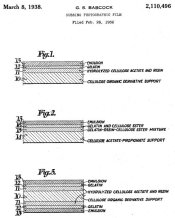Agfa Patent 1976
I was sure that I had a simple subbing formula copied from a book I read, but damned if I can find it.
I also find some of the formulas complex:
Agfa patent UK 1976 11216 or EP0003627 A1
solution A
demin H2O 2460ml
disodiumhydrogen phospate 6.3g
xitric acid 20.4g
urea 432g
ammonium sulphate 72g
Solution B
aqueous colloidal solution of silica 888ml
demin H2O 939ml
6N sulfuric acid to bring ph to 3 21.1ml
Soution C
20% aqueous solution of formaldehyde 576ml
add B to A at 40 degrees C, stirring at 6000 rpm for 2 hours. Add C. stir 15min. decrease rpm to 3000 for 2 hours at 40 degrees C
change ph to 6 with 110ml 2N sodium hydroxide and 300g gelatine stir 300rpm for 1 hour!
Other interesting Patents
US3535147 A
(1) Applying a first coating comprising a dilute aqueous solution of a polyvalent metal salt selected from the group consisting of ferric, stannic, stannous, chromic, and zirconium salts plus a polymer film swelling agent to the polymer film support;
(2) Drying and curing this first coating to form a first subbing layer;
(3) Applying a second coating comprising an aqueous gelatin solution containing a polyvalent metal salt selected from the group consisting of ferric, stannous, stannic, chromic, and zirconium salts plus a polymer film swelling agent to the first subbing layer; and
(4) Drying and curing this second coating to form a second subbing layer.
This one confirms the use of latex:
US3320191 A
A sample of photographic baryta coated paper stock was coated on both sides with a 15 g./m. coating of 50:50 solids blend of polystyrene latex and styrenezbutadiene (60:40) latex. This coated paper was very hydrophobic to water and showed a moisture pickup (Cobb test) of approximately 0.02 g./ 100 cm. after 8 minutes exposure to water at 70 F. A 1.0 g./rn. sub coating of the following composition was then coated over the face side resinous layer.
Material: Weight, gms. Water 907.9 Chelating agent 2.5 Wet-ting agent 1.5 Sodium meta-borate 2.0 Casein 7.6 Polystyrene latex (32.5% solids) 70.0 Gelatin 7.6 40% formaldehyde 0.9
The sub coating was dried by passing the paper first through an air drier at 160-180 F. for l-l5 sec. and then in front of a bank of infrared heaters at 240280 F. for -20 sec. The paper was then coated on the face side with a suitable photographic gelatin-based emulsion, and dried. When processed, no evidence of emulsion frill was noted. The same paper without the sub layer showed a complete sloughing off of the emulsion during processing.
When the same latex coated base was subbed with a 1.0 g./m. sub coating composed of equal parts (by solids weight) of a resin latex mixture of polystyrene resin latexstyrene butadiene resin latex combination (45 :55 by solids weight) and gelatin, adhesion was not considered passable--an objectionable amount of emulsion coating could be rubbed away.
1949 US2461474 A
A film base of cellulose acetate was coated with the following gelatinous substrating composition:
Parts Gelatin 0.73 Water 1.33 Acetic acid 1.20 Diphenylsulfone 1.34 Methanol 75.53
An anti-static gelatin composition suitable for the subbing of a photographic film support, which comprises a gelatin subbing composition containing from 0.5 to 1.5% of gelatin, from 1.33 to 15% of water, from 78 to 95.4% of a solvent for said support, and from 0.5 to of a diphenylsulfone of the following general formula: which comprises a gelatin subbing composition containing from 0.5 to 1.5% of gelatin, from 1.33 to of water, from 78 to 95.4% of a solvent for said support, and from 0.5 to 10% of diphenylsulfone.
1939 US2196775 A
A cellulose acetate photographic film base made from cellulose acetate containing about 40.5% acetyl was coated with a solution having the following composition:
Grams Polymerized methyl acrylate 1 Acetone 10 Methyl alcohol After this coating had dried the following solution was applied:
Grams Cellulose nitrate 1 Methyl alcohol 40 Butyl alcohol This layer was dried and a gelatin sub was then applied having the following composition:
Gelatin g 1 Acetic acid g 1 Water cc 25 Ethyl alcohol cc 25 The gelatin layer was dried and a photographic gelatino silver halide emulsion was then applied in the usual manner.
1938 Mr Babcock US2110496 has the coating speeds and formulas! Enjoy!
:

Russ
 .
. .
.





